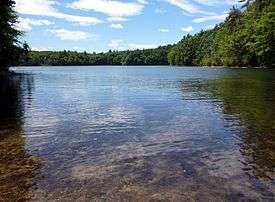Department of Conservation and Recreation
|
Massachusetts Dept. of Conservation and Recreation seal | |
|
Agency logo | |
| Department overview | |
|---|---|
| Headquarters | 251 Causeway Street, Boston |
| Department executive |
|
| Website | |
The Department of Conservation and Recreation (DCR) is a state agency of the Commonwealth of Massachusetts, situated in the Executive Office of Energy and Environmental Affairs. It is best known for its parks and parkways. As of December 9, 2015, the Commissioner of the DCR is Leo Roy.[2] The DCR's mission is "To protect, promote and enhance our common wealth of natural, cultural and recreational resources for the well-being of all."[3] The agency is the largest landowner in Massachusetts.[4]
Administrative history
The Department of Conservation and Recreation was formed in 2003 under Governor Mitt Romney, when the former the Metropolitan District Commission (MDC) and the Department of Environmental Management (DEM) were merged to form the DCR.
Ownership and management for many nonpedestrian bridges was transferred to the Massachusetts Department of Transportation in 2009.[5]
Structure
The DCR is under the general management of the Commissioner of the DCR. The general administration divisions; Human Resources Division, the Financial Division, and External and Legislative Affairs, report directly to the Commissioner. It has two divisions [6]
- Division of State Parks and Recreation (now branded as MassParks)
- Division of Water Supply Protection
and several bureaus, offices, and other work units, including (but not exclusively)
- Bureau of Engineering
- Bureau of Planning and Resource Protection
- Bureaus of Forestry and Fire Control
- Bureau of Ranger Services
- Universal Access Program
- many other units
Division of State Parks
The Division of State Parks is responsible for the maintenance and management of over 310,000 acres (1,250 km2) of state-owned forests and parks. These areas are designated as either Woodlands, Parklands, or Reserves, and are managed to maintain specific land-use characteristics.[7]
From the agency's beginning in 2003 until 2012, DCR land management was organized into three divisions: State Parks and Recreation, Urban Parks and Recreation, and Water Supply Protection. In 2012, State Parks and Urban Parks were unified into one division.[8]
Within the greater Boston area there are urban wilds, historic sites, and other naturally aesthetic or significant environmental properties. The origins of the collective environments in this part of the division date back to the creation of the Metropolitan Park Commission in 1893, forming the first such regional system in the United States.[9] (see Metropolitan Park System of Greater Boston for history).
Lands outside of the greater Boston area includes some 29 campgrounds, over 2,000 miles (3,200 km) of trails, 87 beaches, 37 swimming, wading, and spray pools, 62 playgrounds, 55 ballfields, 145 miles (233 km) of paved bike and rail trails and once private homes and estates that are now a part of the DCR's Historic Curatorship Program.
List of State Parks
Division of Water Supply Protection
The Division of Water Supply Protection manages 150,000 acres (610 km2) of watershed lands and is responsible for the protection of the drinking water supply for approximately 2.5 million residents of Massachusetts, primarily in Greater Boston. This division monitors lakes and ponds, well drillers, and rainfall throughout the Commonwealth.[10]
List of Protected Water Supply Areas
- List of Massachusetts Protected Water Supply Areas
Bureau of Engineering
The Bureau of Engineering provides professional engineering, design, and construction management services in support of DCR properties. In addition to providing engineering services for over 450,000 acres (1,800 km2) of parks, forests, watersheds, beaches, 340 dams, and numerous recreational facilities, the Bureau of Engineering also manages over 525 lane miles of parkways and nearly 300 bridges and tunnels notable for their landmark stature and importance in the Commonwealth’s transportation system.
The Bureau operates under the direction of a Chief Engineer and is sub-divided into six operating units:
- Bridge and Parkway Engineering
- Facilities Engineering
- Dams and Waterways Engineering
- Stormwater and Environmental Engineering
- Construction Permitting
- Construction Services
The Bureau is responsible for the management of the majority of the DCR's annual capital budget which has declined in recent years from a $150–200 Million high to a current $70–80 Million.
List of parkways
The Bureau of Engineering manages and/or operates a number of parkways across the Commonwealth, including:
- Alewife Brook Parkway
- Arborway
- Birmingham Parkway
- Blue Hills Parkway
- Blue Hills Reservation Parkways
- Boylston Street (Back Bay sections)
- Breakheart Reservation Parkways
- Cambridge Parkway
- Carey Circle
- Charles River Reservation Parkways
- Charles Street (Charles Cir. to Leverett Cir.)
- Chestnut Hill Drive
- William J. Day Boulevard
- Fellsway Connector Parkways
- Fellsmere Park Parkways
- Fenway
- Fresh Pond Parkway
- Furnace Brook Parkway
- Hammond Pond Parkway
- Hull Shore Drive
- Jamaicaway
- Land Boulevard
- Lynn Fells Parkway
- Lynnway
- Lynn Shore Drive
- Memorial Drive
- Middlesex Fells Reservation Parkways
- Morrissey Boulevard
- Mount Greylock Summit Road
- Mount Wachusett Summit Road
- Mystic Valley Parkway
- Nahant Beach Boulevard
- Nantasket Avenue
- Neponset Valley Parkway
- North Beacon Street (Brighton & Watertown sections)
- Norumbega Road (Weston)
- Old Harbor Reservation Parkways
- Old Colony Parkway
- Park Drive
- Parkman Drive
- Quincy Shore Drive
- Recreation Road (Weston)
- Revere Beach Boulevard
- Revere Beach Parkway
- Riverway
- Stony Brook Reservation Parkways
- Storrow Drive
- Truman Parkway
- VFW Parkway
- West Roxbury Parkway
- Winthrop Parkway
- Winthrop Shore Drive
List of bridges
The Bureau of Engineering managed and/or operated a number of bridges across the Commonwealth prior to November 2009. All non-pedestrian bridges were transferred to the Massachusetts Department of Transportation on November 1, 2009 as part of a transportation reform law.[5][11] Originally, a certain number of bridges listed in the act creating MassDOT were to be transferred after December 31, 2014 when ongoing construction was completed. However, a Memorandum of Agreement between DCR and MassDOT instead transferred these bridges in 2009 along with all other DCR vehicular bridges.
A partial listing of notable bridges formerly under the DCR, with the exception of pedestrian bridges still managed by the department and listed here, include:
- Alewife Brook Parkway Bridge over MBTA
- Anderson Memorial Bridge (aka Larz Anderson Bridge)
- Boston University Bridge
- Beades Bridge
- Bowker Overpass
- Bridge 23 Revere Beach Parkway over B & M, Corporation Way
- Boston University Pedestrian Bridge
- Casassa Overpass
- Casey Overpass
- Charles Circle 57B
- Cradock Bridge
- Craigie Dam Bridge
- Craigie Drawbridge
- Eliot Bridge
- General Edwards Bridge
- General Edwards Electrical Upgrade
- Gilman Street Bridge
- Gilmore Bridge
- Hammond Pond Parkway Bridge/MBTA
- Harvard Bridge
- Lech Walesa Bridge
- Leo Martin Golf Course Pedestrian Bridge
- Leverett Circle Tunnel
- Longfellow Bridge
- McCarthy Overpass
- Mystic Valley Parkway over Alewife Brook
- Neponset River Bridge
- Pleasure Bay Pedestrian Bridges
- Revere Beach Pkwy/State Road
- River Street at Mother Brook
- River Street Bridge
- Riverside Park Pedestrian Bridge
- Storrow Drive Tunnel
- Watertown Pedestrian Bridge
- West Roxbury Parkway at Conrail
- Winthrop Avenue Bridge
- Woods Memorial Bridge
List of dams
The Bureau of Engineering owns and manages and/or operates a number of dams and flood control facilities across the Commonwealth, including:
- Irish Dam (Grafton)
- Moose Hill Reservoir Dam (Spencer)
- Pontoosuc Lake Dam (Pittsfield)
- Unionville Pond Dam (Holden)
- Charles River Dam (Boston)
Services
DCR is responsible for the stewardship of its lands, from general maintenance—such as emptying trash barrels, cutting grass, and making building improvements—to landscape-level management.
DCR also provides services beyond its boundaries, For example, Bureau of Forest Fire Control is available to aid and assist local cities and towns during natural disasters as well as periods of high fire danger, while its Bureau of Forestry administers forest management on both state and private lands.[12]
DCR also manages its land through the help of partners. Road repairs are sometimes implemented by the Massachusetts Department of Transportation at the request of DCR. Police protection has been provided by the Massachusetts State Police after the MDC's police department was merged into the State Police in 1992.
See also
References
- ↑ http://www.mass.gov/eea/pr-2015/leo-roy-named-commissioner-of-dcr.html
- ↑
- ↑
- ↑ http://www.sledmass.com/legislation.asp
- 1 2 Pazzanese, Christina (September 12, 2009). "A big concern on two major parkways". The Boston Globe. Retrieved 2009-11-05.
- ↑ "Inside Our Agency". Commonwealth of Massachusetts. Retrieved 11 November 2013.
- ↑ "Landscape Designations". Massachusetts Department of Conservation and Recreation. Commonwealth of Massachusetts. Retrieved 11 November 2013.
- ↑ 2012 Annual Report (PDF). Department of Conservation and Recreation. 2012. p. 27. Retrieved 11 November 2013.
- ↑ "Division of Urban Parks and Recreation History". Commonwealth of Massachusetts. Archived from the original on 8 December 2009.
- ↑ "Division of Water Supply Protection". Commonwealth of Massachusetts.
- ↑ "Chapter 25 of the Acts of 2009 (Section 177)". The 186th General Court of The Commonwealth of Massachusetts. Retrieved 2009-11-05.
- ↑ "Bureau of Forestry". Commonwealth of Massachusetts. Retrieved 11 November 2013.


